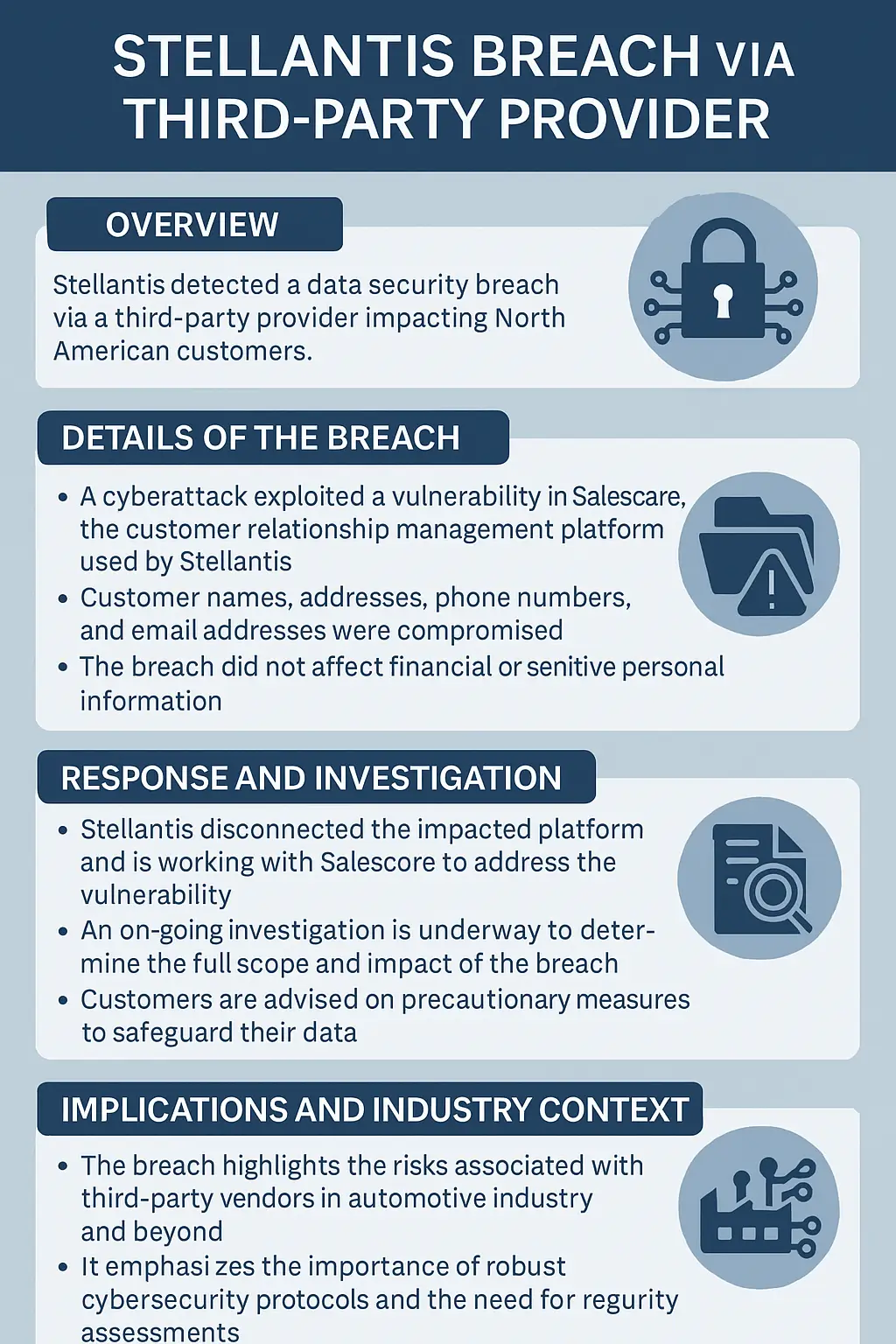Stellantis Breach via Third-Party Provider
Introduction
In September 2025, global automaker Stellantis—the parent company of Chrysler, Jeep, Dodge, and Ram—confirmed a major cybersecurity breach. Unlike many high-profile incidents that involve direct attacks on company servers, this one occurred through a third-party provider, believed to be Salesforce. The breach compromised sensitive customer data across North America, sparking alarm among both consumers and businesses.
For North Carolina businesses, the Stellantis Breach serves as a timely reminder: cybersecurity risks often lurk in unexpected corners. Even if your own defenses are strong, vulnerabilities within your vendors, suppliers, or service providers can still expose you to risk.

Why This Disruption Caught Europe Off Guard
The Scale of Digital Interdependence
Modern airports rely heavily on digital systems. From check-in kiosks to baggage handling, many of the workflows are automated—and interconnected. When the underlying platform faltered, the consequences cascaded. As the World Economic Forum put it, the disruption “exposed the vulnerability of highly digitized processes” across critical infrastructure.
In this case, the failure was traced back to Collins Aerospace’s MUSE (or vMUSE / ARINC MUSE) software—an airport system used by multiple airports to manage passenger processing and boarding. Because many airports used the same vendor platform, a single disruption had continent-wide reach.
Third-Party Risk Became the Achilles’ Heel
The EU agency confirmed that the incident was a third-party ransomware attack—meaning the breach didn’t target the airports directly, but rather a supplier whose software underpins airport operations. That distinction is crucial: even if an airport has strong internal cybersecurity, its exposure to external vendors can undermine its defenses.
This kind of vulnerability isn’t new in theory, but this event felt like a wake-up call: when one vendor fails, many dependent systems can collapse in tandem.
Operational and Human Fallout
The effects were immediate and tangible:
- At Brussels, roughly 60 flights were canceled out of 550 scheduled departures/arrivals.
- Berlin, coinciding with the Berlin Marathon, faced heightened passenger volumes and long delays; airport staff resorted to manual check-ins.
- London Heathrow and other hubs diverted to manual operations, using handwritten boarding passes, external iPads, or other fallback tools.
- Some airports fared better—Dublin, for example, reported only minimal impact.
For passengers, the experience resembled the early days of commercial flight: long lines, ad hoc processes, and uncertainty.
How the Attack Unfolded (So Far)
The timeline and mechanics are still under investigation, but the broad contours are emerging:
- Late Friday, September 19: The disruption began. Systems gradually went offline or became unstable, triggering alarms that something was wrong.
- Weekend (Sept 20–21): The outage expanded across multiple airports. Affected systems included check-in, boarding, baggage drop, and kiosk operations.
- Monday, Sept 22: ENISA (the EU’s cybersecurity agency) publicly confirmed the incident was a ransomware attack targeting a third-party provider.
- Restoration efforts began, with the vendor working to deploy patches or restore encrypted data. Airports gradually brought systems back online while still relying on manual backup processes.
The precise ransomware variant and the identity of the attackers remain unconfirmed. ENISA said that they had “identified the type of ransomware,” but withheld full details pending law enforcement investigation. Some reporting has speculated ties to known families (e.g. REvil / Sodinokibi), though attribution remains tentative.
Interestingly, British police later arrested a man in connection with a related hack—though no definitive attribution to a ransomware group has been established.
European Airports & Cyber Resilience: The Broader Context
This incident isn’t an isolated freak event. Rather, it fits into a tightening trend of infrastructure attacks and hybrid threats. The WEF commentary cautions that digital systems, no matter how advanced, carry fragility.
Some observations worth noting:
- Critical infrastructure status: Airports sit at the junction of physical and digital systems: aviation control, logistics, security, communications—all interwoven with IT. Because they are vital to national economies and mobility, they are inherently attractive to attackers.
- Hybrid threat convergence: Around the same time, Europe saw drone incursions disrupting flights in Denmark and Norway, suggesting that adversaries may be probing multiple vectors simultaneously.
- Regulation catching up: In response, regulators (both EU and national) are likely to demand stricter cybersecurity standards, vendor oversight, and resilience protocols.
- Supply chain vulnerability: This event is a stark case of supply chain risk—where one exploited supplier can domino into widespread disruption.
- Public trust and perception: Travelers expect seamless operations. Extended outages, confusing communications, and delayed flights can damage confidence in aviation infrastructure and raise questions about passenger rights, compensation, or liability.
What North Carolina (and US) Entities Can Learn
While this attack occurred in Europe, its lessons are globally applicable. Here’s how organizations—and even state agencies or transportation entities—can take heed.
- Scrutinize Vendor & Supplier Cyber Risk
No matter how strong your internal security is, your cybersecurity posture is only as strong as your weakest link—often a vendor. Perform rigorous due diligence:
- Require SOC 2 / ISO 27001 / third-party audit certifications
- Mandate cybersecurity clauses in contracts (patching SLAs, incident notification, encryption, liability)
- Conduct periodic security assessments or audits of vendor environments
- Limit vendor privileges (least privilege, segmentation, zero-trust architecture)
- Maintain Manual & Offline Fall-back Options
A recurring theme from the airport disruption: digital systems failed, but manual processes kept operations alive. Without paper boarding passes, handwritten tallying, or stand-alone backups, many airports would have ground to a halt.
Organizations should embed such fallback systems into business continuity plans—test them regularly so they’re not just theoretical.
- Build Coordinated Incident Response Capabilities
Rapid detection and containment were essential. Key elements include:
- A cross-silo incident response team (IT, legal, PR, operations)
- Pre-approved communication templates and stakeholder protocols
- Tabletop exercises simulating ransomware or infrastructure attacks
- Forensic readiness: logging, immutable backups, secure isolation
- Threat Intelligence & Early Warning
Understanding emerging ransomware trends, attacker TTPs (tactics, techniques, and procedures), and public attribution helps organizations fortify their defenses. Use threat intelligence feeds and coordinate with national or sectoral CERTs (Computer Emergency Response Teams).
- Cyber Insurance & Incident Financing
As ransomware attacks grow, organizations increasingly rely on cyber insurance to offset costs. But insurers will want proof of mature cybersecurity practices, vendor risk mitigation, and incident readiness. Being reactive isn’t enough—insurers may refuse claims for sloppy security.
- Government & Policy Engagement
Public infrastructure or transportation systems should coordinate with state/federal agencies (e.g. DHS CISA in the U.S.). Grants or regulations may someday require compliance with cybersecurity frameworks in critical sectors. Engagement helps shape effective policy rather than reactive mandates.
Analogies & Real-World Comparisons
To make this more concrete: imagine a city where dozens of buildings (offices, hospitals, transit depots) all rely on plumbing supplied by a single water treatment plant. If that plant is poisoned or shut down, the entire community is affected—even though each building’s internal plumbing might be flawless. Here, Collins Aerospace’s system served as that central plant: a failure there rippled outward.
In the business world, many companies face something similar: reliance on third-party cloud providers, shared platforms, or supply chains that, if compromised, take down what seems like an otherwise secure operation.
What You (As a Traveler) Should Watch for
If you plan on international travel, including Europe, here are some practical tips:
- Monitor notifications: Airlines and airports may issue alerts if systems are down or operating manually.
- Arrive earlier: Manual check-ins take longer.
- Have backups: Keep digital boarding passes, PDFs, or screenshots accessible offline.
- Be patient: Backlogs are inevitable in such systemic failures.
- Follow trustworthy news sources: In such crises, reliable updates can prevent confusion.
Looking Ahead: Risks, Responses & Lessons
Ongoing Risks
- Lone vendor attacks: Other supply chain dependencies may be exploited next.
- State-sponsored operations: Some suspect that advanced actors may use ransomware as a tool to test resilience or cause strategic disruption (though no firm attribution has been made here).
- Hybrid coordinated attacks: Coupled with drone incursions or physical sabotage, cyber incidents could be part of larger threat campaigns.
- Regulatory compliance pressure: Entities may face fines or liability if they fail to meet mandated cyber standards.
Areas for Improvement
- Inter-airport and cross-border coordination: In Europe, ENISA will likely build more centralized frameworks for cyber incident coordination.
- Threat sharing: Governments, agencies, and private firms must share threat indicators fast.
- Stronger contractual controls with technology suppliers ensuring accountability and resilience.
- Resilience by design: Systems should be built assuming failures will happen—not just optimized for performance, but for graceful degradation under attack.
Conclusion
The recent European airport disruption was more than a blip—it was a powerful reminder that even the most sophisticated systems are vulnerable when external dependencies are weak. The confirmation that it was a ransomware attack orchestrated through a third-party provider underscores how interwoven and fragile critical infrastructure has become.
For entities in North Carolina—whether in transportation, logistics, government, or enterprise—the lessons are direct: vet your vendors, plan for failure, test your responses, and assume attackers are only a step away. The more proactive and coordinated your posture, the better you can weather the inevitable next wave of cyber threats.

